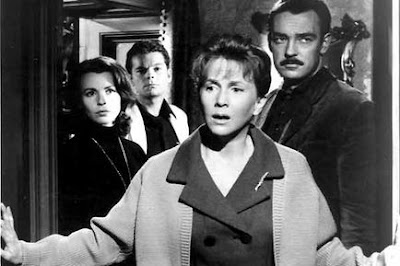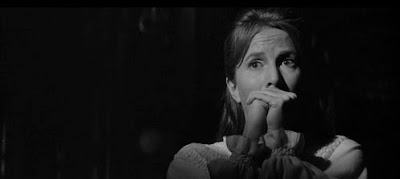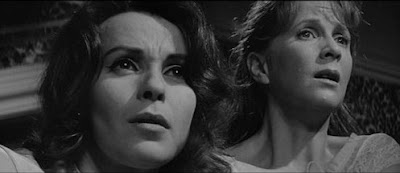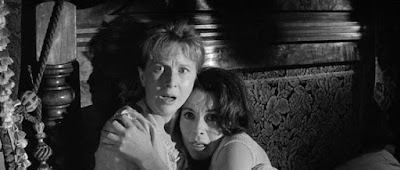Of course, get any group of veteran movie-lovers talking about Haunted House films — the childhood favorites, the best-directed, the most effectively creepy — and two minutes won't pass before someone mentions The Haunting, then others nod in enthusiastic agreement before recounting whichever scene in this 1963 benchmark most freaked the bejeezus out of them. Last October at The Daily Beast, Martin Scorsese, no slouch as a suspense-film buff, ranked The Haunting #1 on his list of 11 scariest movies.
Genre film fans who came of age cinematically during or after the 1980s may find The Haunting too traditional in its narrative, too restrained in its use of the sort of visual or editing tricks that have come to define "scary" movies since the slasher-film and CGI wave. Then again, I'm not far from that generational zone myself and yet here I am. Still, if such a corrupting blind spot exists, I'd hope that double-featuring this movie with its 1999 remake would adequately serve to catalog everything so right about the 1963 version and all that can go so wrong with the post-Freddie Krueger product. Granted, arguably that's an unfair comparison given the sharp distinction — literarily and cinematically — between terror and horror, with the 1963 version embodying the former and the 1999 thudbucket failing to do justice to the latter.
Robert Wise directed this brilliantly executed exercise in restraint and atmospherics between his two all-stops-out musicals West Side Story and The Sound of Music. The contrast couldn't be more startling.
A sober, faithful interpretation of Shirley Jackson's genre-defining novel, The Haunting of Hill House, it easily ranks among the most well-regarded supernatural suspense films ever made, perhaps second only to The Innocents (1961) in its use of mood, suggestion, and not showing what's behind the door to achieve a level of creeps that slithers under your skin and stays there a while. So for me the two films are a natural pairing for a double-feature night (and for this blog, obviously).
I love the opening paragraph of Jackson's 1959 novel, three sculpturally honed sentences that Elizabeth and I have read aloud to each for the minor-key music in their quiet, vivid suggestiveness:
No live organism can continue for long to exist sanely under conditions of absolute reality; even larks and katydids are supposed, by some, to dream. Hill House, not sane, stood by itself against its hills, holding darkness within; it had stood so for eighty years and might stand for eighty more. Within, walls continued upright, bricks met neatly, floors were firm, and doors were sensibly shut; silence lay steadily against the wood and stone of Hill House, and whatever walked there, walked alone."I think," wrote Stephen King in his 1981 nonfiction book Danse Macabre, "there are few if any descriptive passages in the English language that are any finer than this; it is the sort of quiet epiphany every writer hopes for: words that somehow transcend the sum of the parts."
From the first sentence it's established that Hill House isn't just a setting; it's a character in its own right, an entity, an "organism" with a will and plans of its own, and "not sane." Wise and screenwriter Nelson Giddin apparently knew there was no point in trying to one-up Jackson's opening, so Julie Harris's voice-over version of that passage starts the movie on a perfect note, setting the goosebumpy tone before the first minute is done.
Not coincidentally, The Haunting also bears some strong similarities to King's The Shining. It's easy to see how King drew upon Jackson's novel and Wise's film for his own story of a house that was "born bad." In Danse Macabre, King places The Haunting high on his short list of the basic coursework in gut-level fright films, and among the films that contributed something of value to the genre, with a special asterisk for being one of his personal favorites.
The story brings a group of psychic researchers to the "diseased" and "deranged" old New England mansion, a Gothic monstrosity with a sordid history and architecture that mirrors the warped soul of its builder.
A naive academic, Dr. Markway (Richard Johnson), leads a hand-picked collection of amateur investigators: Luke (Russ Tamblyn), heir to the house, is a skeptical hep-cat wise-ass whose only goal is to protect his upcoming investment property. Theodora (Claire Bloom), a sleek and brassy subtexty lesbian, was chosen for her ESP prowess. We also get Lois Maxwell, James Bond's Miss Moneypenny at the time, as Markway's skeptical wife who learns to really, really regret crashing in on her husband's work.
The linchpin of the story is repressed, browbeaten Eleanor (Julie Harris), whose personal history parallels key events in Hill House's sinister past.
The four meet at Hill House to record conclusive evidence of "another world." Hill House is willing to oblige — on its own terms. Seemingly sentient and watchful, the house is particularly interested in Eleanor.
As horrific ghostly eruptions escalate — including a cryptic "help Eleanor Come Home" scrawled on a wall — she is the center of Hill House's attention. Her abusive relationship with her now-dead mother, and an interrupted mixed-signals closeness with Dr. Markway, contribute to a relationship with Hill House that anticipates that of Jack Torrance to The Shining's Overlook Hotel.
Harris's performance is the movie's spine. Eleanor, the sheltered and psychologically broken young spinster, becomes one of the most complex and well-wrought characters in the genre. Through her The Haunting takes on layers of post-Freudian nuance that drives (indeed literally) to its crunching climax.
The Haunting's hypodermic effectiveness derives from the masterful craftsmanship of director Wise. His early apprenticeship was at the feet of legendary producer Val Lewton, whose preference for atmospherics and mood over visceral shocks is visible throughout The Haunting.
In Gidding's tight screenplay, outright "Boo!" moments are few. Instead, Wise (whose creds as an editor include Citizen Kane) builds a powerful sense of dread through off-kilter angles, staccato editing, and Davis Boulton's rich, evocative black-and-white camerawork. Wise's striking compositions put every widescreen square inch to use. He shot the Hill House exteriors on infrared film to give them an unnatural look. Other than that, the movie displays only one visual-effects trick — an oak door bulges inward, like an embolism, because something is pushing against the other side.
It's the use of sound, though, that really elevates The Haunting as a technical tour de force. Two of its most unnerving scenes are all about what we, along with Eleanor, can only hear. When the unseen supernatural presence pounds, boom, Boom BOOM, closer and closer along the hall outside Eleanor and Theo's room, the scare comes from what we can't see hitting the walls and then hammering the door, even as the camera presses us mere inches from the doorknob turning by itself.
Later, in bed, Eleanor hears ghastly chanting and the cries of a child behind the wall flocking (where the decorative pattern suggests a malevolent face) — again neither Eleanor nor we can see anything other than what our imaginations show us, an effect that hits hardest when Eleanor screams, the lights come up, and she realizes that the cold hand she had been holding wasn't Theo's. It's a moment that only a select few screen ghost stories, before or since, have approached.
The current Warner Bros. DVD edition of The Haunting is an essential disc on my shelf despite being a mixed bag. The good news is that the disc presents the film in its original 2.35:1 widescreen. Plus there's a commentary track with Wise, screenwriter Gidding, and all four principal actors; they were recorded separately and the track is only marginally scene-specific, but good information and warm reminiscing are on hand.
Also added are a click-through stills gallery of pages from Wise's original screenplay plus his handwritten notes, a slide-show gallery of promo material, the endearingly overcooked theatrical trailer (in DD 2.0), and a few perfunctory words on cinematic ghost stories.
The less-good news is that the film and audio elements received minimal upgrade attention. Oh, it's a fine print marred only by minor flecks and scratches, but the contrast is boosted a bit too high, resulting in greater sharpness but diminished grayscale detail and a few overblown whites. More disappointing is the audio track, which is clean and clear but quite thin, even for its vintage, in low-fi Dolby 1.0 monaural. Expect to crank up your volume control for a satisfactory level. None of which is a show-stopper, mind you. It's just that The Haunting's complex and scarifying sound cries out for a stereo or 5.1 surround remix option. Given a mindful, expertly managed sound enhancement using its original elements, Chapter 12 — boom, Boom BOOM — all by itself would be a real pants-wetter.
Music: All the John Lennon on my iPod (a lot) on the day that would have been his 70th birthday.
Near at hand: An Advanced Reading Copy of Manu Joseph's Serious Men















